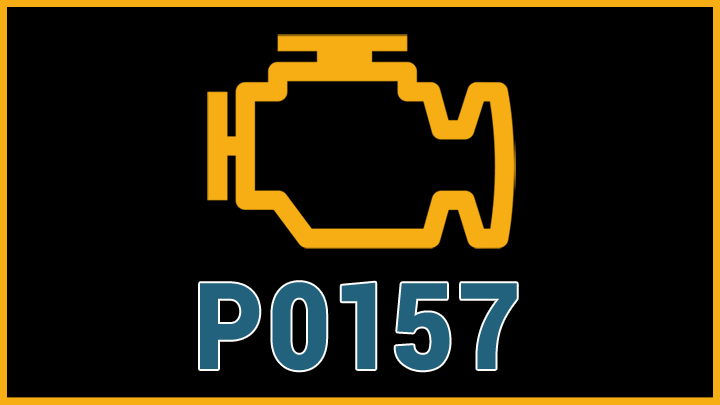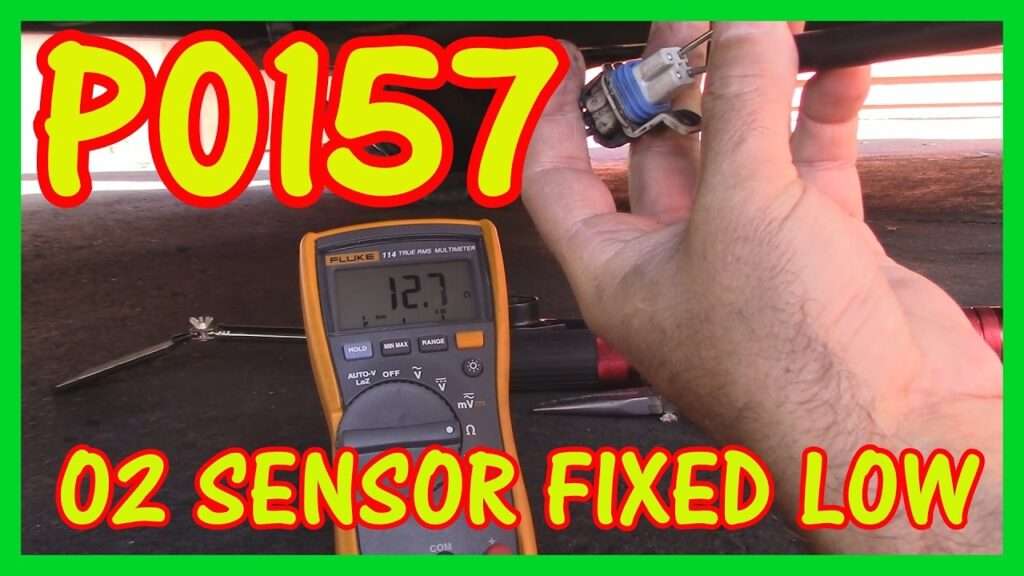
P0157 O2 Sensor Circuit Low Voltage (Sensor 2, Bank XNUMX)
Content
P0157 – OBD-II Trouble Code Technical Description
Trouble code P0157 indicates a low voltage in the oxygen sensor circuit (sensor 2, bank 2).
What does the fault code mean P0157?
Trouble code P0157 indicates a problem with the Oxygen Sensor on circuit 2, bank 2, at the second oxygen sensor after the catalytic converter. This code means that the engine control module (ECM) has detected that the voltage on the downstream oxygen sensor circuit on the second cylinder bank is too low.

Possible reasons
Possible causes of DTC P0157:
- Defective oxygen sensor: The oxygen sensor itself may be damaged or failed, resulting in an incorrect reading of the oxygen content of the exhaust gases.
- Damaged wiring or connectors: Opens, corrosion, or poor connections in the wiring or connectors connecting the oxygen sensor to the engine control module (ECM) can cause the P0157 code.
- Problems with power or grounding of the oxygen sensor: Improper power or grounding of the oxygen sensor can cause the signal circuit to go low, causing P0157.
- Malfunctions in the engine control module (ECM): Problems with the engine control module, which processes signals from the oxygen sensor, can also cause P0157.
- Problems with the catalyst: Catalyst failures can cause the oxygen sensor to malfunction, which can cause P0157.
- Incorrect installation of the oxygen sensor: Improper installation of the oxygen sensor, such as too close to a hot source such as the exhaust system, can cause a P0157 code.
- Problems with the exhaust system: Malfunctions or leaks in the exhaust system can also cause the oxygen sensor circuit to become low and cause P0157.
- Problems with other sensors or vehicle systems: Some problems with other vehicle sensors or systems, such as the air flow sensor, ignition system, or fuel injection system, can also affect the performance of the oxygen sensor and cause the P0157 code.
What are the symptoms of a fault code? P0157?
With DTC P0157, the following symptoms may occur:
- Check Engine Light (CEL): One of the most common symptoms of a P0157 code is the Check Engine Light coming on on your dashboard. This may be the first sign of trouble for the driver.
- Unstable idle: Improper operation of the oxygen sensor can cause the engine to idle rough, especially when running on a cold engine.
- Loss of power: Improper operation of the oxygen sensor may result in loss of power during acceleration or require higher engine speeds to achieve the desired speed.
- Increased fuel consumption: Incorrect correction by the engine management system due to low voltage at the oxygen sensor may result in increased fuel consumption.
- Unstable engine performance: Other symptoms may include rough running of the engine, including shaking, rough idling, and instability at low or high speeds.
- Increased emissions of harmful substances: Improper functioning of the catalytic system due to improper operation of the oxygen sensor can lead to increased emissions of harmful substances into the atmosphere.
- Problems with passing technical inspection: If you have a required inspection, a P0157 may cause this process to fail.
These symptoms may occur to varying degrees and may depend on the specific operating conditions of the vehicle. If you notice one or more of these symptoms, it is recommended that you contact a qualified auto mechanic to diagnose and repair the problem.
How to diagnose a fault code P0157?
To diagnose DTC P0157, you can follow these steps:
- Checking the error code: Use an OBD-II scanner to read the P0157 trouble code from the Engine Control Module (ECM). Write down this code for later diagnosis.
- Visual inspection of the oxygen sensor: Inspect the oxygen sensor and its wiring for visible damage, corrosion, or disconnections. Make sure the sensor is in place and connected correctly.
- Checking wiring and connectors: Check the condition of the wiring and connectors connecting the oxygen sensor to the engine control module. Make sure the wiring is not damaged and all connections are tight.
- Oxygen sensor testing: Use a multimeter to check the voltage at the oxygen sensor terminals. Compare the obtained values with the expected values specified in the manufacturer's technical documentation.
- ECM signal check: Check the signal from the oxygen sensor to the engine control module (ECM). Make sure the ECM is receiving a signal from the oxygen sensor.
- Checking the exhaust system: Check the condition of the catalytic converter and other exhaust system components for damage or blockages that could affect the operation of the oxygen sensor.
- Checking other sensors and systems: Check the operation of other sensors and systems, such as the ignition system, fuel injection system and crankcase ventilation system, which may affect the operation of the oxygen sensor.
- Additional tests: Depending on the diagnostic results, additional tests may be required, such as testing for exhaust system leaks or testing for failure of other engine management system components.
After diagnosing and identifying the problem, it is necessary to carry out the appropriate repairs or replacement of components according to the detected malfunction. If you are not experienced in diagnosing and repairing your vehicle, it is recommended that you contact a qualified auto mechanic or service center for professional assistance.
Diagnostic errors
When diagnosing DTC P0157, the following errors may occur:
- Incorrect interpretation of oxygen sensor data: One of the most common mistakes is misunderstanding the data received from the oxygen sensor. This can lead to misdiagnosis and replacement of components that are not actually causing the problem.
- Incorrect checking of wiring and connectors: Improper handling of wiring and connectors, such as accidentally disconnecting or damaging wires, can cause additional problems and create new errors.
- Ignoring other potential causes: Focusing only on the oxygen sensor without considering other possible causes of the P0157 code, such as problems with the exhaust system or fuel injection system, can lead to important details being missed.
- Poor decision to repair or replace components: Making the wrong decision to repair or replace components without sufficient diagnosis and analysis can result in additional repair costs and ineffective resolution of the problem.
- Failed diagnostic tests: Improperly performed diagnostic tests or the use of inappropriate equipment can lead to unreliable results and incorrect conclusions about the causes of the P0157 code.
To avoid these mistakes, it is important to follow professional diagnostic techniques, use the correct equipment, perform tests in accordance with the manufacturer's recommendations and, if necessary, contact an experienced technician for help and advice.
How serious is the fault code? P0157?
Trouble code P0157 indicates a problem with the oxygen sensor (Oxygen Sensor) of the second bank (bank 2), sensor 2 (Sensor 2) after the catalytic converter. Although it is not a critical emergency, the P0157 code should be considered a serious problem that requires immediate attention for the following reasons:
- Impact on engine efficiency: A faulty oxygen sensor can cause the engine management system to make incorrect adjustments, which can ultimately lead to loss of power, poor fuel economy, and other engine performance problems.
- Impact on environmental performance: Insufficient oxygen in exhaust gases can lead to increased emissions of harmful substances into the atmosphere, which can negatively impact the environment and attract the attention of regulatory authorities.
- Increased fuel consumption: Incorrect operation of the oxygen sensor may result in incorrect adjustments by the engine management system, which may ultimately result in increased fuel consumption.
- Possibility of further damage to the catalyst: A faulty oxygen sensor can cause the catalytic converter to malfunction, which can eventually damage it and require replacement, which is a serious and costly problem.
- Failure of technical inspection: If your vehicle passes inspection, a P0157 fault may cause it to fail and therefore make the vehicle temporarily unusable on the road.
Considering the above factors, it is recommended that you contact a professional for diagnosis and repair when trouble code P0157 appears.
What repair will help eliminate the code? P0157?
To resolve DTC P0157, you can perform the following steps, depending on the detected cause of the problem:
- Replacing the oxygen sensor (Oxygen Sensor): If the oxygen sensor is faulty or failed, it should be replaced with a new one that meets the manufacturer's specifications. Typically this sensor is located after the catalyst.
- Checking and servicing wiring and connectors: Check the condition of the wiring and connectors connecting the oxygen sensor to the engine control module (ECM). If necessary, repair or replace damaged wires or connectors.
- Checking and servicing the exhaust system: Check the condition of the catalytic converter and other exhaust system components for damage or blockages. If necessary, replace or repair faulty components.
- Checking and updating software (if necessary): Check if engine control module (ECM) software updates are available. A software update may help resolve the problem if it is related to software errors.
- Checking other systems and components: Check other vehicle systems and components that may affect the performance of the oxygen sensor, such as the ignition system, fuel injection system, etc.
- Carrying out additional diagnostic tests: If necessary, additional tests may be required to identify other potential problems that could cause the P0157 code.
After diagnosing and identifying the cause of the P0157 error, it is necessary to carry out the appropriate repairs or replacement of components according to the detected malfunction. If you are unsure of your skills or experience, it is recommended that you have your vehicle professionally diagnosed and repaired by a qualified auto mechanic or service center.
P0157 – Brand-specific information
Deciphering the P0157 trouble code for some specific car brands:
- Volkswagen (VW): P0157 – “Oxygen Sensor Circuit Low Voltage (Bank 2, Sensor 2)”.
- Ford: P0157 – “Oxygen Sensor Circuit Low Voltage (Bank 2, Sensor 2)”.
- Chevrolet / GMC: P0157 – “Oxygen Sensor Circuit Low Voltage (Bank 2, Sensor 2)”.
- Toyota: P0157 – “Oxygen Sensor Circuit Low Voltage (Bank 2, Sensor 2)”.
- BMW: P0157 – “Oxygen Sensor Circuit Low Voltage (Bank 2, Sensor 2)”.
- Mercedes-Benz: P0157 – “Oxygen Sensor Circuit Low Voltage (Bank 2, Sensor 2)”.
- Audi: P0157 – “Oxygen Sensor Circuit Low Voltage (Bank 2, Sensor 2)”.
- Honda: P0157 – “Oxygen Sensor Circuit Low Voltage (Bank 2, Sensor 2)”.
- Hyundai: P0157 – “Oxygen Sensor Circuit Low Voltage (Bank 2, Sensor 2)”.
- Nissan: P0157 – “Oxygen Sensor Circuit Low Voltage (Bank 2, Sensor 2)”.
This is a general explanation for the specified error code. It is recommended to clarify the information for the specific model of your car for a more accurate understanding of the situation.